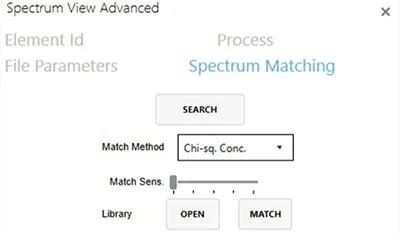The EDAX Spectrum Match software program assists users in exploring a custom spectrum library to find analogous spectra, simplifying the task of discerning differences and similarities between spectra and facilitating the identification of unknowns by comparing them to a curated list of potential candidates. Spectrum Match stands out for its adaptability and finds application in a range of scenarios, including:
- Reverse engineering - Users can leverage a library of common material components to compare material constituents effectively.
- Process control - Integrating phase mapping and spectrum matching enables the immediate detection of changes in distribution and composition.
- Failure analysis and quality control - It facilitates the comparison of defects with a database of potential contaminants.

Figure 1. Spectrum matching uses either Chi-Square fit on the spectrum intensities or Chi-Square fit on the concentration results. Image Credit: Gatan

Figure 2. Spectrum extracted from the map visibly and numerically identifies this phase as SbS with a much higher fit % compared to CaSO4, even though they contain common elements. Image Credit: Gatan
The chi-squared goodness of fit test directly compares concentrations or spectra, aligning the active spectrum with entries in the library file (Figure 1). Users can fine-tune the match sensitivity, granting them full authority over the match outcomes, which can range from an exact match to a close approximation.
The potential matching spectra are overlaid onto the original spectrum, offering both a numerical evaluation of their similarity and a visual representation of any disparities.
Figure 2 shows a sample spectrum, featuring two overlay spectra with match values of 81.53% for SbS and 62.64% for CaSO4. A quick visual inspection indicates that the disparities between the sample and the best-matching spectrum are most notable in the Si, Ti, Ba, and Zr content.
The spectrum search tool simplifies the creation of a library of spectrum matches. Users can manually select specific project nodes or apply filters to navigate the extensive database of stored spectra within the system. These filters encompass:
- Presence of given elements (with range in atomic %, weight %, or net intensity)
- Sample name
- kV used
- Acquisition date
Once selected, the spectra are saved to a Spectrum Match library file, which can subsequently be shared among different users and systems. Additionally, there is an option to include all the information from the system database in this Spectrum Match library file.
Smart Materials and Minerals Library
The EDAX Smart Materials and Minerals Library comprises 150 entries for common metal standard alloys and minerals. This comprehensive library includes:
- 90 steel spectra
- Tool steels
- Carbon steels
- Stainless steels
- Alloy steels, Ni-based steels, Cu-based alloys
- 50+ silicates and other geological standard materials
